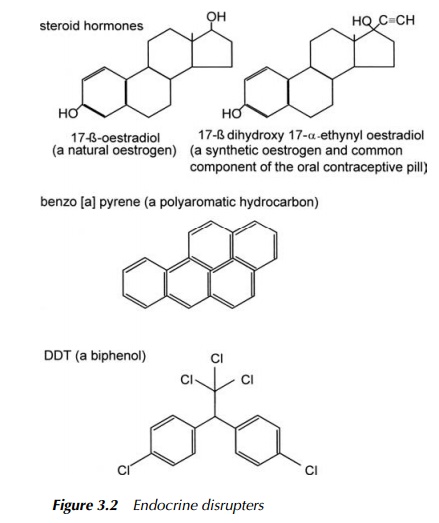Chapter: Environmental Biotechnology: Fundamentals of Biological Intervention
Endocrine disrupters - Biological Intervention
Endocrine disrupters
To date, there are chemicals, including xenobiotics, which still
resist degradation in the environment. This may be due to a dearth, at the site
of contamination, of organisms able to degrade them fully or worse, microbial
activity which changes them in such a way that they pose a bigger problem than
they did previously. One such example is taken from synthetic oestrogens such
as 17α-ethinyloestradiol commonly
forming the active ingredient of the birth control pills, and the nat-ural
oestrogens which, of course, are not xenobiotics. Natural oestrogens are
deactivated in humans by glucuronidation, as shown in Figure 3.1, which is a
conjugation of the hormone with UDP-glucuronate making the compound more

polar and easily cleared from the blood by the kidneys. It is in this
modified and inactive form that it is excreted into the sewage. However,
bacteria present in the aerobic secondary treatment in sewage treatment plants,
have the enzyme,-glucuronidase, which
removes this modification thus reactivating the hormone.
As an aside, glucuronidation
is not confined to hormones but is a process used to detoxify a number of
drugs, toxins and carcinogens in the liver. The enzyme catalysing this process
is induced in response to prolonged exposure to the toxin thus imparting increased
tolerance or even resistance to the chemical.
Returning to the problem of
elevated levels of active hormones in the water-ways, another aspect is that
steroids do not occur in bacteria, although they are present in fungi, and so
bacteria lack the necessary pathways to allow com-plete degradation of these
hormones at a rate compatible with the dwell time in sewage treatment plants.
The consequence has been raised levels of reactivated oestrogen and 17α-ethinyloestradiol in the waterways leading to
disturbances of the endocrine, or hormonal, system in fauna downstream from
sewage treat-ment plants. Such disturbances have been monitored by measuring
the presence of the protein vitellogenin (Sole et al. 2001) which is a precursor to egg yolk protein, the results
of which have indicated feminisation of male fish in many species including
minnows, trout and flounders. The source of environmental oestrogens is not
confined to outfall from sewage treatment plants, however, the fate of
endocrine disrupters, examples of which are given in Figure 3.2, in sewage
treatment plants is the subject of much research (Byrns 2001). Many other
chemicals, including polyaromatic hydrocarbons (PAHs),
dichlorodiphenyl-trichloroethane (DDT), alkyl phenols and some detergents may also
mimic the activity of oestrogen. There is general concern as to the ability of
some organisms to accumulate these endocrine disrupters in addition to the
alarm being raised as to the accumulative effects on humans of oestrogen-like
activity from a number of xenobiotic sources.

To date there is no absolute
evidence of risk to human health but the Environ-mental Agency and Water UK are
recommending the monitoring of environmen-tal oestrogens in sewage treatment
outfall. Assays are being developed further to make these assessments
(Gutendorf and Westendorf 2001) and to predict poten-tial endocrine disrupter
activity of suspected compounds (Takeyoshi et
al 2002). Oestrogen and progesterone are both heat labile. In addition,
oestrogen appears to be susceptible to treatment with ultra-violet light, the
effects of which are augmented by titanium dioxide (Eggins 1999). The oestrogen
is degraded com-pletely to carbon dioxide and water thus presenting a plausible
method for water polishing prior to consumption.
Another method for the
removal of oestrogens from water, in this case involv-ing Aspergillus, has also been proposed (Ridgeway and Wiseman 1998).
Sulpha-tion of the molecule by isolated mammalian enzymes, as a means of
hormone inactivation is also being investigated (Suiko 2000). Taken overall, it
seems unlikely that elevated levels of oestrogen in the waterways will pose a
problem
Related Topics